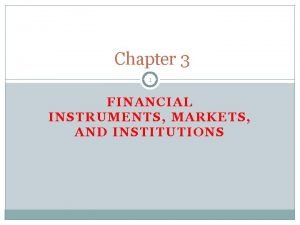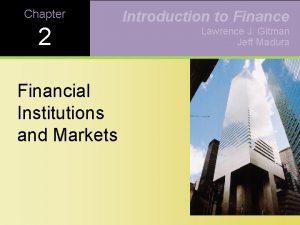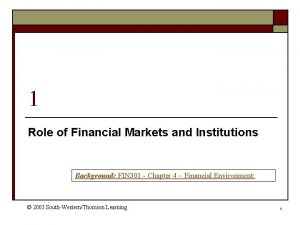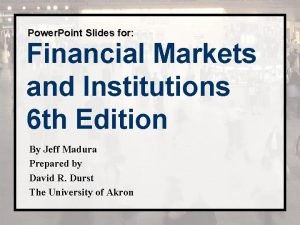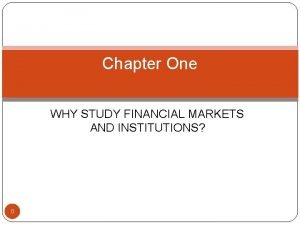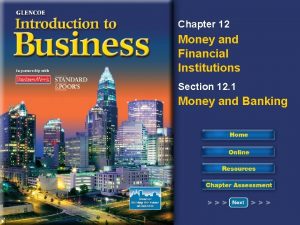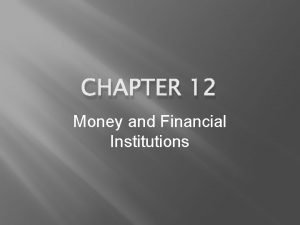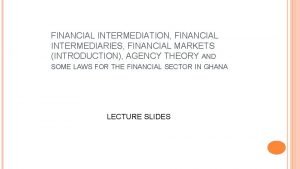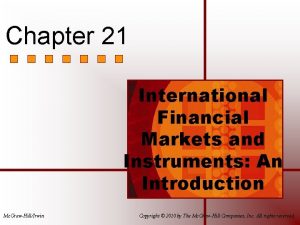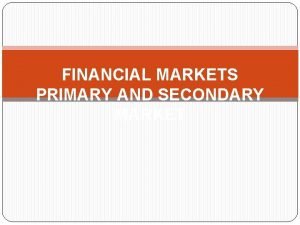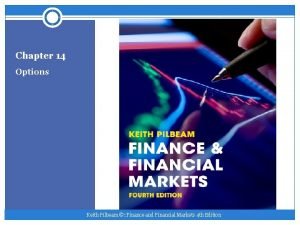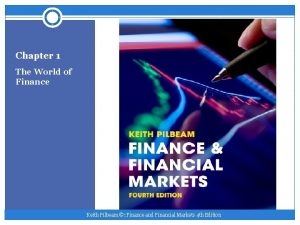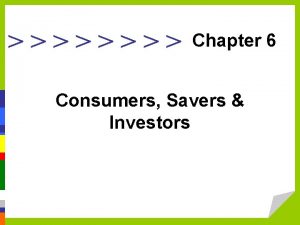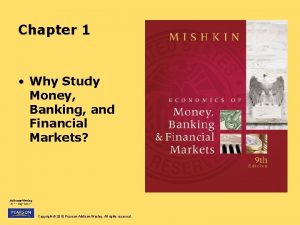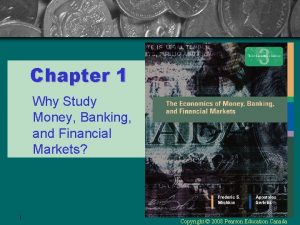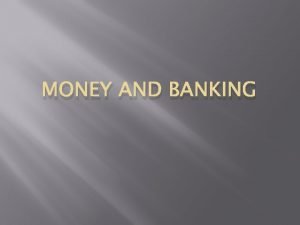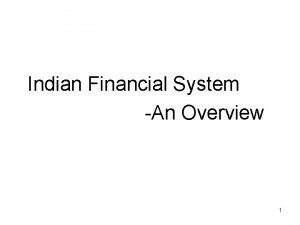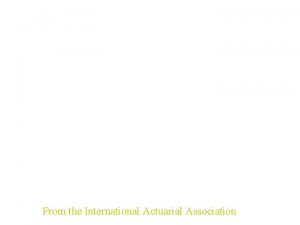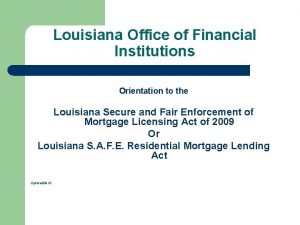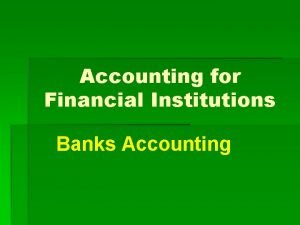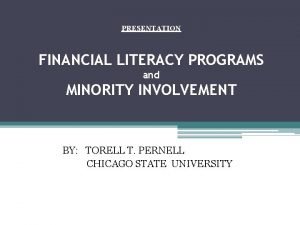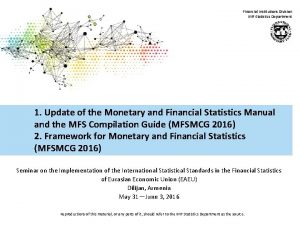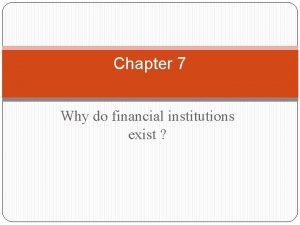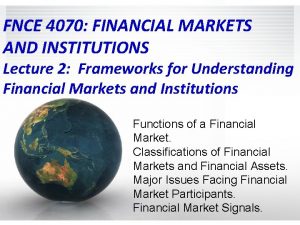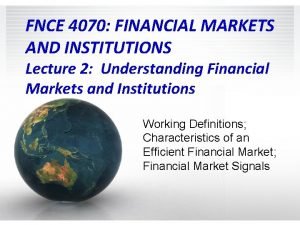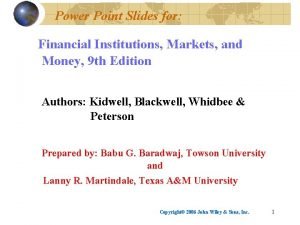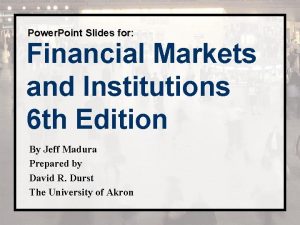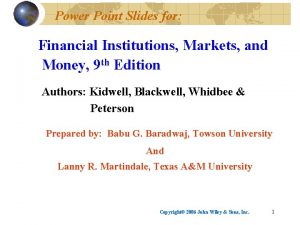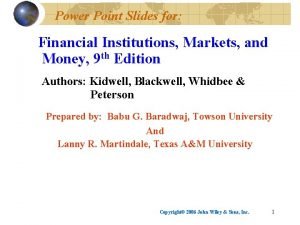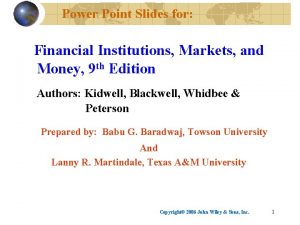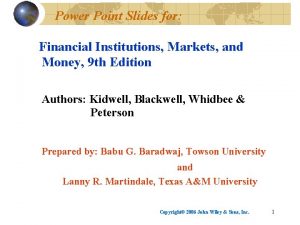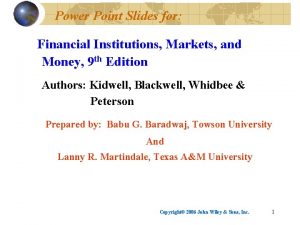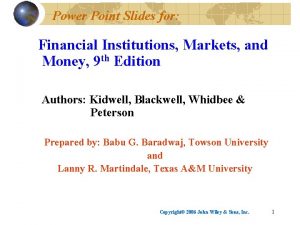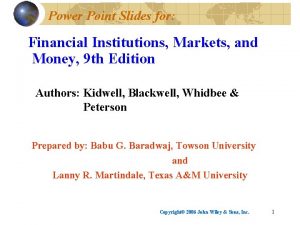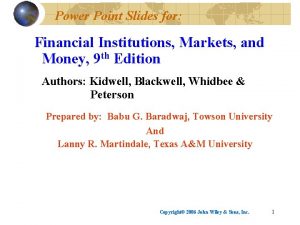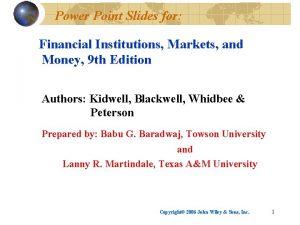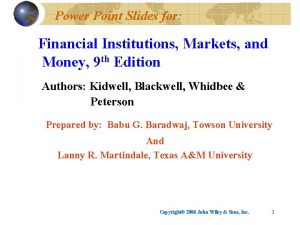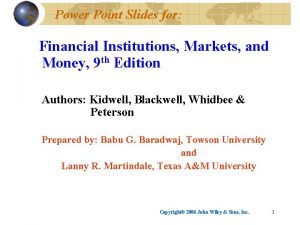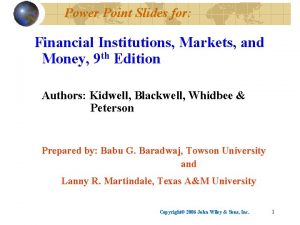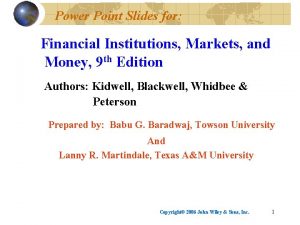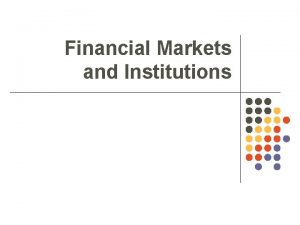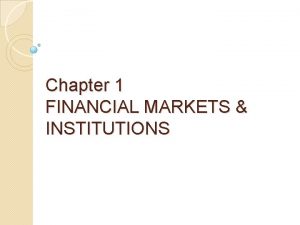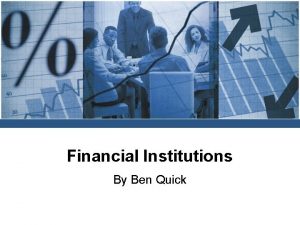Power Point Slides for Financial Institutions Markets and



































- Slides: 35

Power Point Slides for: Financial Institutions, Markets, and Money, 9 th Edition Authors: Kidwell, Blackwell, Whidbee & Peterson Prepared by: Babu G. Baradwaj, Towson University And Lanny R. Martindale, Texas A&M University Copyright© 2006 John Wiley & Sons, Inc. 1

CHAPTER 7 Money Markets Copyright© 2005 John Wiley & Sons, Inc

Overview of the Money Market Short-term debt market - most under 120 days. A few high quality borrowers. Many diverse investors. Informal market centered in New York City. Standardized securities -- one security is a close substitute for another. Copyright© 2006 John Wiley & Sons, Inc. 3

Overview of the Money Market (concluded) Good marketability - secondary market. Large, wholesale open-market transactions. Many brokers and dealers are competitively involved in the money market. Payment in Federal Funds - immediately available funds. Physical possession of securities seldom made - centralized safekeeping. Copyright© 2006 John Wiley & Sons, Inc. 4

Money Market Securities Outstanding Copyright© 2006 John Wiley & Sons, Inc. 5

Economic Role of Money Market (MM) The money market is a market for liquidity Liquidity is stored in MM by investing in MM securities. Liquidity is bought in MM by issuing securities (borrowing). Liquidity status of commercial banks is reflected Provides a place for Fed’s reserve transactions (open market transactions) Indicator of economic conditions Copyright© 2006 John Wiley & Sons, Inc. 6

Characteristics of Money Market Instruments Low default risk. Short maturity. High marketability. Copyright© 2006 John Wiley & Sons, Inc. 7

U. S. Treasury Bills Characteristics Sold on discount basis. Maturities up to one year. Minimum denomination is usually $10, 000, but smaller investors can invest in multiples of $1, 000 through the Treasury Direct Program offered by the Fed. Lowest interest rate of all MM securities is the 3 -month T-Bill Copyright© 2006 John Wiley & Sons, Inc. 8

How to Read T-Bill Quotes Copyright© 2006 John Wiley & Sons, Inc. 9

U. S. Treasury Bills Pricing Treasury Bills Treasury bills are priced on a bank discount rate basis, a traditional yield calculation. The bank discount rate, yd , is: Copyright© 2006 John Wiley & Sons, Inc. 10

U. S. Treasury Bills The Wall Journal lists T-Bill yields on a bond equivalent basis where the discounted price is the denominator and 365 days is used as the annualizer. The effective annual yield assuming compounding a year is: Effective Yield = [(Face Value/Price)365/D -1] x 100%. Copyright© 2006 John Wiley & Sons, Inc. 11

Auctioning New Bills Weekly sale by U. S. Treasury of three- and six-month maturities; longer-term bills, monthly or quarterly. T-bills are sold through an auction process using both competitive and noncompetitive bids. Copyright© 2006 John Wiley & Sons, Inc. 12

Auctioning New Bills contd. Competitive Bids Specify price and quantity desired. Minimum $10, 000 & in multiples of $5, 000 above $10, 000. Mostly professionals - dealers & banks. No more than 35 percent of an issue is sold under the competitive bidding process in order to ensure a competitive secondary market. Copyright© 2006 John Wiley & Sons, Inc. 13

Auctioning New Bills contd. Non-competitive Bids All non-competitive bids accepted. Specify quantity only. Maximum $1, 000. Mostly individuals & small investors. Pays weighted average price of competitive bids accepted. Copyright© 2006 John Wiley & Sons, Inc. 14

Book-entry Securities No physical securities: only record entries. Book-entry record keeping Most of marketable Treasury debt is now in book- entry form. Participants in Treasury Direct program are book-entry accounts. Copyright© 2006 John Wiley & Sons, Inc. 15

Types of Federal Agencies Farm credit agencies - loans to farmers. Housing credit agencies - loans and secondary market support for mortgage market. Other agencies - special purposes. Federal Financing Bank - purchases securities of agencies and issues its own obligations. Copyright© 2006 John Wiley & Sons, Inc. 16

Characteristics of Agency Debt Most are not guaranteed by federal government; federal guarantee implied, not explicit. Marketability varies with the development of the secondary market. Yields are higher than T-Bills. Slightly greater default risk. Slightly lower marketability. Copyright© 2006 John Wiley & Sons, Inc. 17

Negotiable Certificates of Deposit Characteristics of Negotiable CDs Large denomination time deposit, less than six month's maturity. Negotiable - may be sold and traded before maturity. Issued at face value with coupon rate. Interest computed on a 360 day year. Primary market sales have CDs of denominations of at least $100, 000. Secondary market deals are for $1 million or more. Payment by banks from fed funds in NY. Interest rates on CDs are higher than on T-Bills higher credit risk, lower marketability and higher taxability. Copyright© 2006 John Wiley & Sons, Inc. 18

Negotiable Certificates of Deposit Development of the CD Market Issued by Citibank in 1961. Offset declining demand deposits as a source of funds. The CD Market Rate negotiated between buyer and seller. Market is sensitive to rates above or below the market rates. Rates are lower for money center banks and are tiered upward for regional banks. Purchased mainly by corporate businesses. Copyright© 2006 John Wiley & Sons, Inc. 19

Commercial Paper Short term - one to 270 days. Unsecured. Large denominations -- $100, 000 and up. Issued by high - quality borrowers. A wholesale money market instrument - few personal investors. Sold at a discount from par. Directly or dealer sold. Backed by bank lines of credit. Copyright© 2006 John Wiley & Sons, Inc. 20

The Commercial Paper Market Major investors Commercial banks. Insurance companies. Nonfinancial business firms. Bank trust departments. State and local pension funds. Banks are involved Backup lines of credit. Act as agents in issuance. Hold notes in safekeeping. Facilitate payment in Federal Funds. Copyright© 2006 John Wiley & Sons, Inc. 21

The Commercial Paper Market (concluded) Credit ratings important for commercial paper issuance. Backup lines of credit from banks support or guarantee quality. Placement Directly by a sales force of the borrowing firm. Indirectly through dealers. Copyright© 2006 John Wiley & Sons, Inc. 22

Bankers' Acceptances Time draft - order to pay in future. Drafts are drawn on and/or accepted by commercial bank. Direct liability of bank. Mostly relate to international trade. Secondary market - dealer market. Discounted in market to reflect yield. Standard maturities of 30, 60, or 90 days max of 180. Copyright© 2006 John Wiley & Sons, Inc. 23

Creating a Banker's Acceptance Importer initiates purchase from foreign exporter, payable in future. Importer needs financing; exporter needs assurance of payment in future. Importer's bank writes irrevocable letter of credit for exporter Specifies purchase order. Authorizes exporter to draw time draft on bank. Copyright© 2006 John Wiley & Sons, Inc. 24

Creating a Banker's Acceptance (concluded) Importer's bank accepts draft (liability to pay) and creates a banker's acceptance. Advantage of a banker's acceptance (BA) Exporter receives funds by selling BA in the market. Exporter eliminates foreign exchange risk. Importer's bank guarantees payment of draft in future. Copyright© 2006 John Wiley & Sons, Inc. 25

Tracing a Banker’s Acceptance Transaction Copyright© 2006 John Wiley & Sons, Inc. 26

Federal Funds Characteristics of Federal Funds Market for depository institutions. Most liquid of all financial assets. Related to monetary policy implementation. Yields related to the level of excess bank reserves. Originally a market for excess reserves - Now a source of investment (federal funds sold) and continued financing (federal funds purchased). Most are one-day, unsecured Loans. Bookkeeping entry -interest paid separately. Traded in Fed Funds or Immediately Available Funds. Copyright© 2006 John Wiley & Sons, Inc. 27

Repurchase Agreements (Repo) Bank Financing - Source of funds Security sold under agreement to repurchase at given price in future. Way to include corporate business in Federal Funds market. Negotiated market rate. Bank Investment – Reverse Repo Security purchased under agreement to resell at given price in future. Smaller banks are able to invest excess liquidity in a secured investment. Copyright© 2006 John Wiley & Sons, Inc. 28

Repurchase Agreements (concluded) The interest rate on a repo is lower than the fed funds rate, since it is backed up by a security. Repos are used by the Federal Reserve in open market operations. Government securities dealers use repos to secure funds to invest in new Treasury issues. Banks participate in the repo market to secure funds to meet temporary liquidity needs as well as lend funds when they have excess reserves. Copyright© 2006 John Wiley & Sons, Inc. 29

Money Market Position of Major Participants Copyright© 2006 John Wiley & Sons, Inc. 30

Commercial Banks Most important participant in the MM Bank assets or investments Treasury bills. Agency securities. Bankers' acceptances (from other banks). Federal Funds sold. Repurchase agreements (securities purchased under agreements to resell). Copyright© 2006 John Wiley & Sons, Inc. 31

Commercial Banks, cont. Bank liabilities or borrowing Negotiable CDs. Commercial paper. Bankers' acceptances. Federal Funds purchased. Repurchase agreements (securities sold under agreements to repurchase). MM securities provides sources and uses of liquidity due to wide fluctuations in loans and deposits. Copyright© 2006 John Wiley & Sons, Inc. 32

The Federal Reserve in the Money Markets Money market securities is the major asset category of the Fed. Open-market operations (buying and selling of MM securities by Fed) is the primary tool for implementing monetary policy. Purchase - increases member bank reserves. Sale - decreases member bank reserves. Copyright© 2006 John Wiley & Sons, Inc. 33

Dealers in U. S. Securities Involved in both primary and secondary markets. Purchases new treasury debt and resells it (primary). "Makes a market" by buying/selling (dealer) securities (bid/ask). Purchases are financed by repurchase agreements or fed funds. Dealers have a very small capital base and are highly leveraged. Copyright© 2006 John Wiley & Sons, Inc. 34

Interrelationship of Money Market Interest Rates Various MM instruments are close substitutes in investment portfolios. Interest rates move together over time. Deviations from traditional spreads are quickly eliminated by interest rate arbitrage. Copyright© 2006 John Wiley & Sons, Inc. 35
 Why study financial markets and institutions
Why study financial markets and institutions Participants in money market
Participants in money market Financial institutions and markets lecture notes ppt
Financial institutions and markets lecture notes ppt Financial markets instruments and institutions
Financial markets instruments and institutions Madura j. financial markets and institutions
Madura j. financial markets and institutions Equity securities
Equity securities Madura j financial markets and institutions
Madura j financial markets and institutions Why study financial markets and institutions
Why study financial markets and institutions Chapter 12 money and financial institutions
Chapter 12 money and financial institutions Chapter 12 money and financial institutions
Chapter 12 money and financial institutions Financial intermediaries and markets
Financial intermediaries and markets International financial markets and instruments
International financial markets and instruments Capital markets and financial intermediation
Capital markets and financial intermediation Primary and secondary financial markets
Primary and secondary financial markets Financial markets and the allocation of capital
Financial markets and the allocation of capital Foreign exchange and international financial markets
Foreign exchange and international financial markets Pilbeam k. finance and financial markets
Pilbeam k. finance and financial markets Keith pilbeam
Keith pilbeam Chapter 6 consumers savers and investors
Chapter 6 consumers savers and investors Why study money banking and financial markets
Why study money banking and financial markets Why study money banking and financial markets
Why study money banking and financial markets A small child slides down the four frictionless slides
A small child slides down the four frictionless slides Change in energy quick check
Change in energy quick check Functions of financial institutions
Functions of financial institutions Introduction to financial institutions
Introduction to financial institutions Functions of financial system
Functions of financial system Types of non banking financial institutions
Types of non banking financial institutions Enterprise risk management for financial institutions
Enterprise risk management for financial institutions Louisiana office of financial institutions
Louisiana office of financial institutions Finanial institutions accounting
Finanial institutions accounting Financial literacy at minority serving institutions
Financial literacy at minority serving institutions Whats a banking institution
Whats a banking institution Financial institutions division
Financial institutions division Why do financial institutions exist
Why do financial institutions exist Classification of financial markets
Classification of financial markets Classification of financial markets
Classification of financial markets



